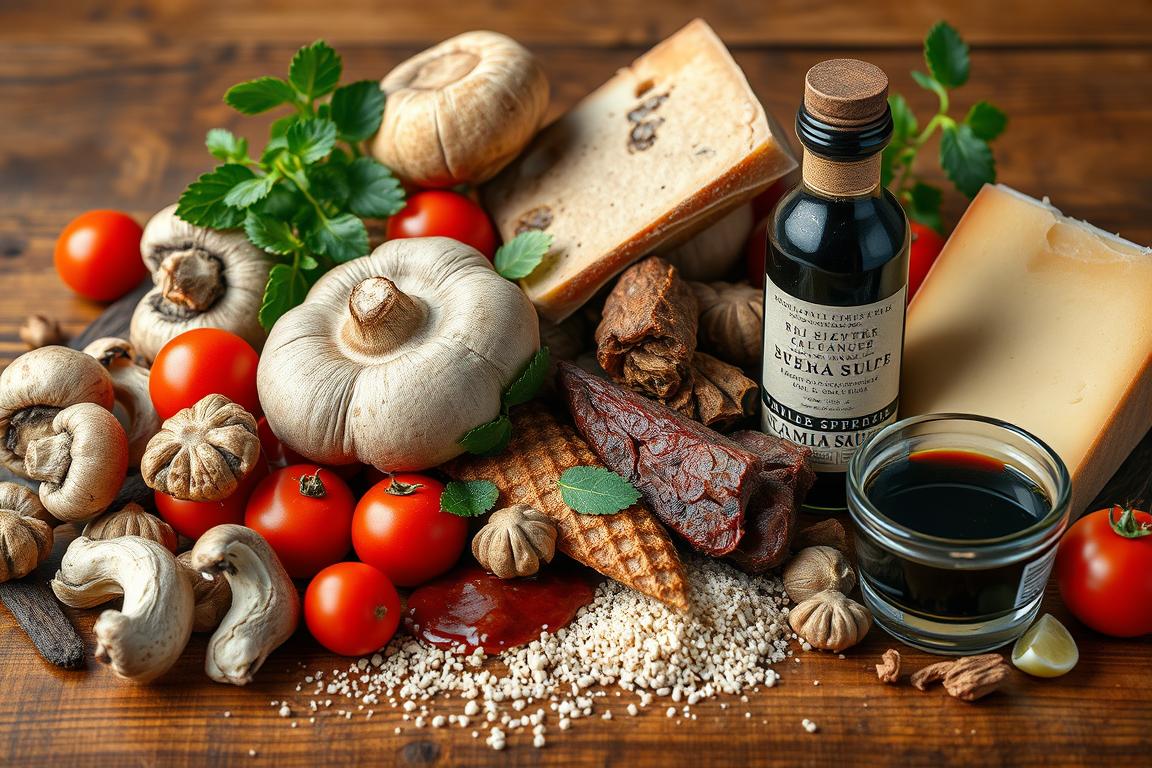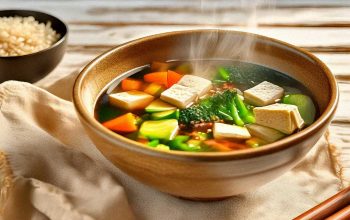The world of taste is more than just sweet, sour, salty, and bitter. There’s a fifth taste called umami that’s gaining attention. It’s a savory flavor that adds depth to food, loved by chefs and food lovers.
Umami comes from the Japanese words for “delicious.” It’s a rich, meaty taste that stays on your tongue. It’s found in many traditional foods, from Asian sauces to European cheeses. Recently, umami has become a key focus in cooking, thanks to our growing understanding of its role in enhancing flavors.
We’re going to explore the fascinating world of umami together. We’ll look at its science, history, and how it’s used in cooking. By diving into the savory side of taste and flavor, we’ll see how umami can make simple dishes taste amazing.
What is Umami?
Umami is the fifth basic taste, along with sweet, sour, salty, and bitter. It’s often called a savory or meaty flavor. This taste comes from certain amino acids, especially glutamate, in foods. Glutamate is a key amino acid for umami.
The Science Behind Umami
Our taste buds detect umami through special receptors. These receptors on our tongue’s surface pick up glutamate and other amino acids. This sends a signal to our brain, making us feel the umami taste. It helps us know when we’re eating nutrient-rich foods.
The Role of Amino Acids
Amino acids are crucial for umami flavor. Besides glutamate, amino acids like aspartate and ribonucleotides like inosinate and guanylate add to umami. Together, they make foods taste savory and meaty.
| Amino Acid | Contribution to Umami |
|---|---|
| Glutamate | Primary umami-inducing amino acid |
| Aspartate | Enhances umami flavor |
| Inosinate and Guanylate | Amplify and synergize with glutamate |
The History of Umami
Umami, the savory flavor, has a long history across ancient cultures and continents. The term “umami” was coined in the early 20th century. Yet, people have enjoyed its unique taste for centuries.
Umami in Ancient Cultures
Aged cheeses, fermented sauces, and cured meats were key in ancient cooking. The Romans loved garum, a fermented fish sauce. The Chinese used soy sauce, preserved veggies, and dried mushrooms in their dishes.
Discovering Umami in Japan
In 1908, Japanese chemist Kikunae Ikeda discovered umami as the fifth basic taste. He found that monosodium glutamate (MSG) is key to umami’s savory taste. His work changed how we see umami in food.
Ikeda’s research led to MSG’s use in food. MSG is still debated but is a big part of many foods. It adds to the umami taste we love in modern dishes.
“Umami is a delicious taste that cannot be created in any other way except through the proper balance of the fundamental tastes – sweet, sour, salty, and bitter.”
– Kikunae Ikeda
The Five Basic Tastes
In the world of food, the five basic tastes are crucial. They are sweet, sour, salty, bitter, and umami. These tastes shape our taste perception and are key to flavor balance in cooking and dining.
Sweet, Sour, Salty, Bitter, and Umami
Each taste adds something special to our flavor experience. Sweet tastes feel comforting and indulgent. Sour flavors refresh us. Salty tastes balance everything, and bitter notes add depth.
Umami, the fifth taste, brings a savory richness. It can make even simple dishes stand out.
The Importance of Taste in Cooking
Knowing how these tastes work together is vital for cooks. Mastering flavor balance can make dishes unforgettable. A well-seasoned steak, a balanced vinaigrette, or a rich dessert can all be transformed by the right taste profiles.
“The true essence of a dish lies in the harmony of its flavors, where each taste component plays a vital role in creating a symphony for the senses.”
Exploring the five basic tastes opens up new possibilities in cooking. It can turn simple ingredients into something amazing.
Food Sources of Umami
Umami-rich ingredients are key to making dishes flavorful. Savory meats, seafood, fermented foods, and umami-packed veggies are essential. They add depth and richness to our food.
Rich Umami Ingredients
Protein-rich foods like aged cheeses, cured meats, and fatty fish are full of umami. Aging, drying, or fermenting these foods breaks down proteins. This creates the meaty, savory taste we love.
Fermented Foods and Their Umami Boost
Fermentation boosts umami in foods. Soy sauce, miso, and aged cheeses get their flavor from microbes. Even plant-based ferments like kimchi and sauerkraut add umami to meals.
Umami-Rich Vegetables
- Tomatoes: Full of glutamates, tomatoes add a rich, savory taste.
- Mushrooms: Shiitake and porcini mushrooms are umami powerhouses.
- Seaweeds: Kombu and nori are known for their umami-rich flavors.
- Potatoes: The spud has glutamates that make it satisfyingly meaty.
Adding these umami-rich ingredients to your cooking can make any dish better. It creates a memorable dining experience.
How to Enhance Umami in Cooking
Unlocking umami flavors can turn simple dishes into masterpieces. By trying different cooking methods and pairing foods, you can make your meals more exciting. This will surely delight your taste buds.
Cooking Techniques to Boost Umami
Some cooking methods can make umami flavors stronger. Roasting, grilling, and slow-cooking are great for this. They use the Maillard reaction to create a deep, savory taste.
Also, searing, caramelizing, and simmering can bring out umami in your food. These methods help reveal the natural umami in ingredients like meats, veggies, and dairy.
Pairing Foods for Maximum Flavor
Pairing foods can make umami flavors work together better. Mixing umami-rich foods like aged cheeses, fermented sauces, and mushrooms creates a balanced taste. This makes your meals more enjoyable.
Trying different cooking methods and food combinations is key to mastering umami. By exploring, you can find new ways to add depth and complexity to your dishes.
“The secret to unlocking the true essence of umami lies in the perfect harmony of cooking techniques and ingredient pairings.”
Umami in Different Cuisines
Umami’s impact is seen worldwide in food. Different cultures have used its savory taste in their dishes. Japanese and Italian foods, for example, rely heavily on umami for their unique flavors.
Japanese Cuisine and Umami
In Japan, umami is key. Dishes like sushi, ramen, and miso soup get their flavor from umami. Ingredients like kombu, bonito flakes, and soy sauce are essential, making umami an art in Japan.
Italian Dishes Rich in Umami
Italian food also loves umami. Parmigiano-Reggiano cheese and sun-dried tomatoes add a rich taste. Cured meats, aged cheeses, and sauces like Parmesan make Italian dishes famous.
The Global Influence of Umami
Umami’s reach goes beyond Japan and Italy. Global cuisine now values its savory taste. Chefs and home cooks worldwide use umami-rich traditional dishes for their depth. From mushrooms in French food to soy sauce in Asian dishes, umami connects all.
https://www.youtube.com/watch?v=-YpUvqKb_B0
The Health Benefits of Umami
Umami, the fifth basic taste, is getting more attention for its health perks. It’s not just about its savory taste. Umami-rich foods also offer benefits that can boost our health.
Enhancing Flavor Without Excess Salt
Umami is great for adding flavor without needing lots of salt. It’s a big help for those trying to cut down on sodium. This makes it easier to eat well without too much salt.
Umami and Appetite Control
Research shows umami might help control hunger and boost satiety. Foods rich in umami can make you feel full. This could help you eat less and manage your weight better. Adding umami to meals can make you feel more satisfied and less likely to overeat.
| Umami-Rich Ingredients | Potential Health Benefits |
|---|---|
| Parmesan cheese | Provides umami flavor while reducing sodium intake |
| Mushrooms | May enhance feelings of satiety and support weight management |
| Soy sauce | Offers umami flavor with less sodium than traditional salt |
By using umami, you can make your meals more flavorful and healthy. It helps cut down on sodium and can help control hunger. Adding umami to your diet is a simple way to eat better and feel better.
The Role of Umami in Snacks
People are looking for bold flavors in their snacks. Umami, the fifth basic taste, adds a savory and meaty taste. It makes even simple snacks more satisfying.
Popular Umami-Rich Snacks
Snack brands are using umami to make tasty treats. Some top umami-rich snacks include:
- Roasted seaweed snacks, which harness the natural umami of the sea
- Savory nuts and seeds, like roasted almonds or pumpkin seeds, enhanced with umami-rich seasonings
- Fermented snacks like miso-flavored crackers or tempeh chips, which derive their umami punch from the fermentation process
- Umami-infused jerky, which combines the satisfying texture of dried meat with the depth of umami flavor
Umami’s Impact on Snack Preferences
Umami-rich snacks are more than just tasty. They can make our brains feel good. This is why people love snacks with a strong umami flavor. It’s changing the snack food world.
| Snack Category | Examples of Umami-Rich Varieties | Key Umami Ingredients |
|---|---|---|
| Chips | Barbecue, sour cream and onion, cheese-flavored | Monosodium glutamate (MSG), yeast extract, parmesan cheese |
| Popcorn | Truffle, parmesan, cheddar cheese | Parmesan cheese, truffle oil, yeast extract |
| Nuts and Seeds | Roasted and seasoned almonds, pumpkin seeds, cashews | Soy sauce, Worcestershire sauce, yeast extract |
| Jerky | Teriyaki, Korean BBQ, peppered | Soy sauce, Worcestershire sauce, garlic, onion |
The snack industry is always changing. Umami-rich flavors will keep driving new and tasty savory snacks.
Umami and Home Cooking
Exploring umami flavors can make home cooking better. You’ll find many tips and techniques to add this savory taste to your meals.
Tips for Adding Umami at Home
To use umami in cooking, choose the right ingredients and methods. Keep soy sauce, Parmesan cheese, anchovies, mushrooms, and tomatoes on hand. These ingredients can make your dishes taste better.
Use techniques like searing, browning, and caramelizing to bring out umami. Slow-cooking, fermentation, and aging also enhance umami flavors.
Creating Umami Balance in Recipes
Getting the umami balance right is key for great-tasting meals. Umami adds depth, but it needs to be balanced with sweetness, sourness, and saltiness.
Try different mixes of umami ingredients with other flavors. For example, soy sauce with caramelized onions or balsamic vinegar can make a dish perfect.

Using umami in your cooking can make your meals more flavorful. It adds sophistication to your everyday dishes. Let your creativity shine with umami-rich recipes.
Misconceptions About Umami
Umami is still a mystery to many, with myths and misconceptions around it. Let’s uncover the truth behind these common beliefs.
Debunking the MSG Myths
Many think MSG, a flavor enhancer, is bad for health. They call it “Chinese Restaurant Syndrome.” But, research proves MSG is safe and natural. It doesn’t cause headaches or nausea when eaten in small amounts.
Clarifying Misunderstandings
- Umami and MSG are not the same. Umami is a natural taste found in foods, while MSG is a man-made enhancer.
- Foods like aged cheeses and mushrooms have umami naturally. They don’t have to have MSG to taste good.
- Eating MSG in small amounts is okay. Health groups say it’s not linked to serious health problems.
Knowing the truth about umami helps us enjoy its rich flavors. It’s time to embrace this fifth taste in our cooking.
The Future of Umami
The world of food is always changing, and umami is becoming more popular. People everywhere are loving the deep, savory taste of umami. This trend is expected to grow as more people seek out bold flavors.
Trends in Umami-Enhanced Products
Food makers are now making more umami-rich products. You can find everything from savory snacks to gourmet condiments with more umami. Items like soy sauce chips, mushroom powders, and special seasonings are becoming common.
The Growing Popularity of Umami
- More people know about umami as the fifth basic taste.
- There’s a need for healthier flavor enhancers instead of MSG.
- Exploring different cuisines is making umami more popular.
- There’s a growing interest in how flavors work and umami’s role.
Umami’s future looks exciting. With new products and recipes, this flavor will keep changing the way we eat. It will add depth and variety to our food for years to come.
| Emerging Umami-Enhanced Products | Key Ingredients |
|---|---|
| Savory Snacks | Soy sauce, miso, dried mushrooms, seaweed |
| Gourmet Condiments | Fermented pastes, mushroom powders, fish sauce |
| Umami-Boosted Seasonings | Nutritional yeast, kombu, anchovies, parmesan |
“The future of umami lies in its ability to captivate the senses and transform the way we experience food. As culinary boundaries continue to expand, the depth and complexity of umami will undoubtedly become an integral part of the global gastronomic landscape.”
Umami and Beverages
Umami, known for its savory taste, is found in unexpected drinks. It adds depth to coffee, tea, and wine pairings. This shows umami’s reach goes beyond just food.
Coffee and Tea: Unexpected Umami
Coffee and tea lovers might be surprised to find umami in their drinks. Coffee’s roasting and tea’s amino acid breakdown bring out umami. This adds to the flavor complexity and makes the drink more enjoyable.
Wine Pairings with Umami Foods
Pairing umami-rich foods with drinks can be tricky. But, some wines match their flavors perfectly. Full-bodied reds like Cabernet Sauvignon go well with meaty dishes. Crisp whites, such as Sauvignon Blanc, complement seafood and veggies.
“The interplay between umami flavors and wine can create a truly harmonious dining experience.”
Knowing about umami in drinks and foods helps chefs and mixologists. They can create pairings that make meals more enjoyable. This lets everyone enjoy the flavor complexity of each dish.

Exploring Umami in Desserts
Umami, the fifth taste, is now in desserts. Chefs are mixing sweet and umami flavors. This creates new and exciting desserts.
Sweet and Savory: Umami in Sweets
Adding umami to desserts might seem odd. But it can bring a new level of taste. Ingredients like miso and parmesan cheese add depth to sweet dishes.
Innovative Umami Dessert Recipes
Umami desserts range from savory-sweet tarts to umami ice creams. Here are some ideas:
- Miso-Caramel Tart with a Salty-Sweet Filling
- Parmesan Cheesecake with a Balsamic Reduction
- Roasted Tomato and Basil Sorbet
- Dark Chocolate Mousse with a Soy Sauce Drizzle
These desserts mix savory and sweet. They offer a unique taste experience.
| Dessert Innovation | Flavor Combinations |
|---|---|
| Miso-Caramel Tart | Salty-sweet miso and caramel |
| Parmesan Cheesecake | Umami-rich parmesan and balsamic reduction |
| Roasted Tomato and Basil Sorbet | Savory tomato and aromatic basil |
| Dark Chocolate Mousse | Indulgent chocolate and soy sauce |
Umami in desserts is a new trend. It brings dessert innovation and flavor combinations to the table.
Conclusion: The Depth of Umami
Umami flavors are truly remarkable, with a depth and complexity that’s hard to match. It has a rich history and has greatly influenced food around the world. Umami makes our meals better by adding depth and balance, making every bite special.
Embracing Umami in Everyday Meals
Now that we know more about umami, cooking becomes more exciting. By using umami-rich ingredients, we can make simple dishes taste amazing. A savory stew or a hearty pasta sauce can become extraordinary with the right touch of umami.
The Lasting Impact of Umami on Dining
As we all learn to love flavors more, umami will become even more important in food. It will inspire new products and improve old recipes. Embracing umami helps us enjoy food more, connect with it on a deeper level, and appreciate the art of cooking.



